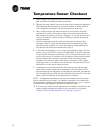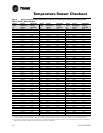
RLC-SVD03A-EN 15
Temperature Sensor Checkout
With the exception of the thermostats located in the motor windings of the
screw compressors, all the temperature sensors used on the UCMs are
negative temperature coefficient (NTC) thermistors. The thermistors
employed all have a base resistance of 10 Kohms at 77F (25C) and display a
decreasing resistance with an increasing temperature. The UCMs “read” the
temperature by measuring the voltage developed across the thermistors in a
voltage divider arrangement with a fixed internal resistance. The value of this
“pull-up” resistor is different depending on the temperature range where the
most accuracy is desired. The voltage source for this measurement is a
closely regulated 5.0 VDC supply.
An open or shorted sensor will cause the UCM to indicate the appropriate
diagnostic. In most cases, an open or short will cause a CMR or MMR
diagnostic that will result in a machine or circuit shutdown. Open or shorts on
less critical Outdoor Air or Zone Temperature sensors will result in an
Informational Warning Diagnostics and the use of default values for
that parameter.
Temperature Sensor Checkout Procedure
ƽ WARNING
Live Electrical Components!
During installation, testing, servicing and troubleshooting of this
product, it may be necessary to work with live electrical
components. Have a qualified licensed electrician or other
individual who has been properly trained in handling live
electrical components perform these tasks. Failure to follow all
electrical safety precautions when exposed to live electrical
components could result in death or serious injury.
1. Measure the temperature at the sensor using an accurate thermometer.
Record the temperature reading observed.
2. With the sensor leads connected to the UCM and the UCM powered,
measure the DC voltage across the sensor leads at the terminal or probe
the back of the MTA plug.
NOTE: Always use a digital volt-ohmmeter with 10 megohm or greater input
impedance to avoid “loading down” the voltage divider. Failure to do so will
result in erroneously high temperature calculations.
3. Locate the appropriate sensor table. Table 3: Evaporator Water and
Refrigerant Temperature Sensors, Table 4: Saturated Condenser Refriger-
ant and Entering Oil Temperature Sensors. Then compare the tempera-
ture in the table corresponding to the voltage reading recorded in Step 2
with the actual temperature observed in Step 1. If the actual temperature
measured falls within the allowable tolerance range, both the sensor and
the UCM's temperature input circuits are operating properly. However, if
the actual temperature is outside the allowable sensor tolerance range,
proceed to Step 4.


















